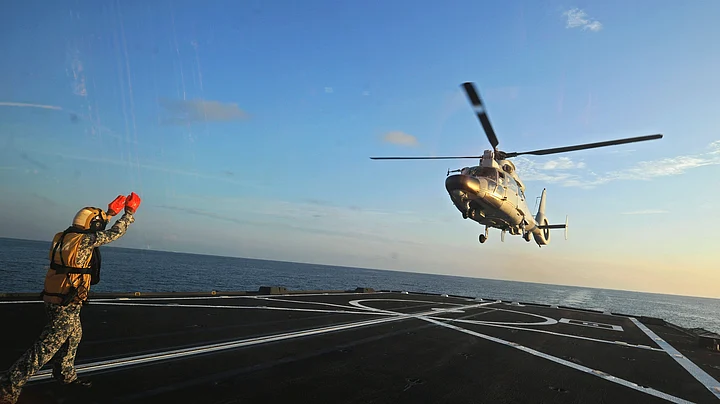It’s now official. The PLA navy has for the first time acknowledged its plan to up the ante in South China Sea in response to increasing tension in the area. In its newly unveiled military strategy White Paper on May 26, China has clearly indicated ambitions for a ‘greater naval presence further from its shores,’ issuing a blunt warning to countries it considers are ‘busy meddling’ in the South China Sea.
“A tiny few maintain constant close-in air and sea surveillance and reconnaissance against China,” the White Paper said. “It is thus a long-standing task for China to safeguard its maritime rights and interests.” Although the White Paper avoided naming smaller countries like Vietnam and the Philippines it pointedly named the US and Japan, and was explicit in its aim of increasing Chinese naval combat power. The paper, released by China’s State Council, said the PLA navy would gradually expand its “offshore waters defence” to include “open seas protection.”
“As the world economic and strategic center of gravity is shifting ever more rapidly to the Asia-Pacific region, the US carries on its ‘rebalancing’ strategy and enhances its military presence and its military alliances in this region. Japan is sparing no effort to dodge the post-war mechanism, overhauling its military and security policies. Such development has caused grave concerns among other countries in the region.
Growing Self-Confidence
“On the issues concerning China’s territorial sovereignty and maritime rights and interests, some of its offshore neighbours take provocative actions and reinforce their military presence on China’s reefs and islands that they have illegally occupied. Some external countries are also busy meddling in South China Sea affairs; a tiny few maintain constant close-in air and sea surveillance and reconnaissance against China. It is thus a long-standing task for China to safeguard its maritime rights and interests,” the paper warned.
The White Paper, much different from the one issued two years ago, reflects China’s growing self-confidence as one of the two major players (the other being the US) in internal affairs. Unlike the 2013 paper, China has once again spoken about not entering into a nuclear arms race.
“The nuclear force is a strategic cornerstone for safeguarding national sovereignty and security. China has always pursued the policy of no first use of nuclear weapons and adhered to a self-defensive nuclear strategy that is defensive in nature. China will unconditionally not use or threaten to use nuclear weapons against non-nuclear-weapon states or in nuclear-weapon-free zones, and will never enter into a nuclear arms race with any other country,” the paper says.
The paper has no direct mention of India although one line – “Certain disputes over land territory are still smoldering” – is a dead giveaway since China has only two land boundary disputes pending. One is with tiny Bhutan and the other with India. The other big takeaway is China’s open acknowledgement about trouble within its own border – in Tibet and in Xinjiang.
Tensions Will Continue
“China faces a formidable task to maintain political security and social stability. Separatist forces for ‘East Turkistan independence’ and ‘Tibet independence’ have inflicted serious damage, particularly with escalating violent terrorist activities by ‘East Turkistan independence’ forces,” the paper admits.
That the South China Sea will continue to be the focal point of rising tension was evident when Beijing declared, almost simultaneously with the release of the military strategy paper, the news of new construction in the area. China will continue building on the islands and reefs in the South China Sea to serve vessels passing through the waters, a foreign ministry representative said on Tuesday, the Global Times reported.
On May 26, the ministry of transport began construction of two lighthouses on Huayang and Chigua reefs in the Nansha Islands. The two 50-metre lighthouses, with lanterns of 4.5 meters in diameter, are designed to have a light range of 22 nautical miles.
China must fulfill international obligations on maritime search and rescue, disaster prevention and mitigation, marine research, meteorological observation, environmental protection, navigation security and fishery production, foreign ministry spokesperson Hua Chunying told a daily news briefing, the Global Times said. Clearly, tension in South China Sea, is only set to rise in coming weeks given that the US flew extensive reconnaissance missions over these reefs last week.
(The writer is a national security analyst)
